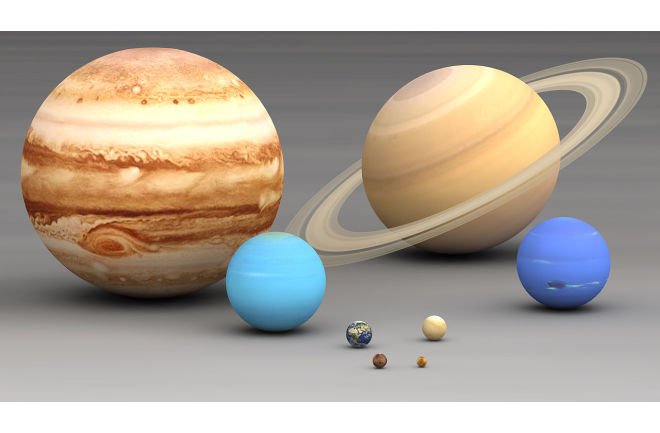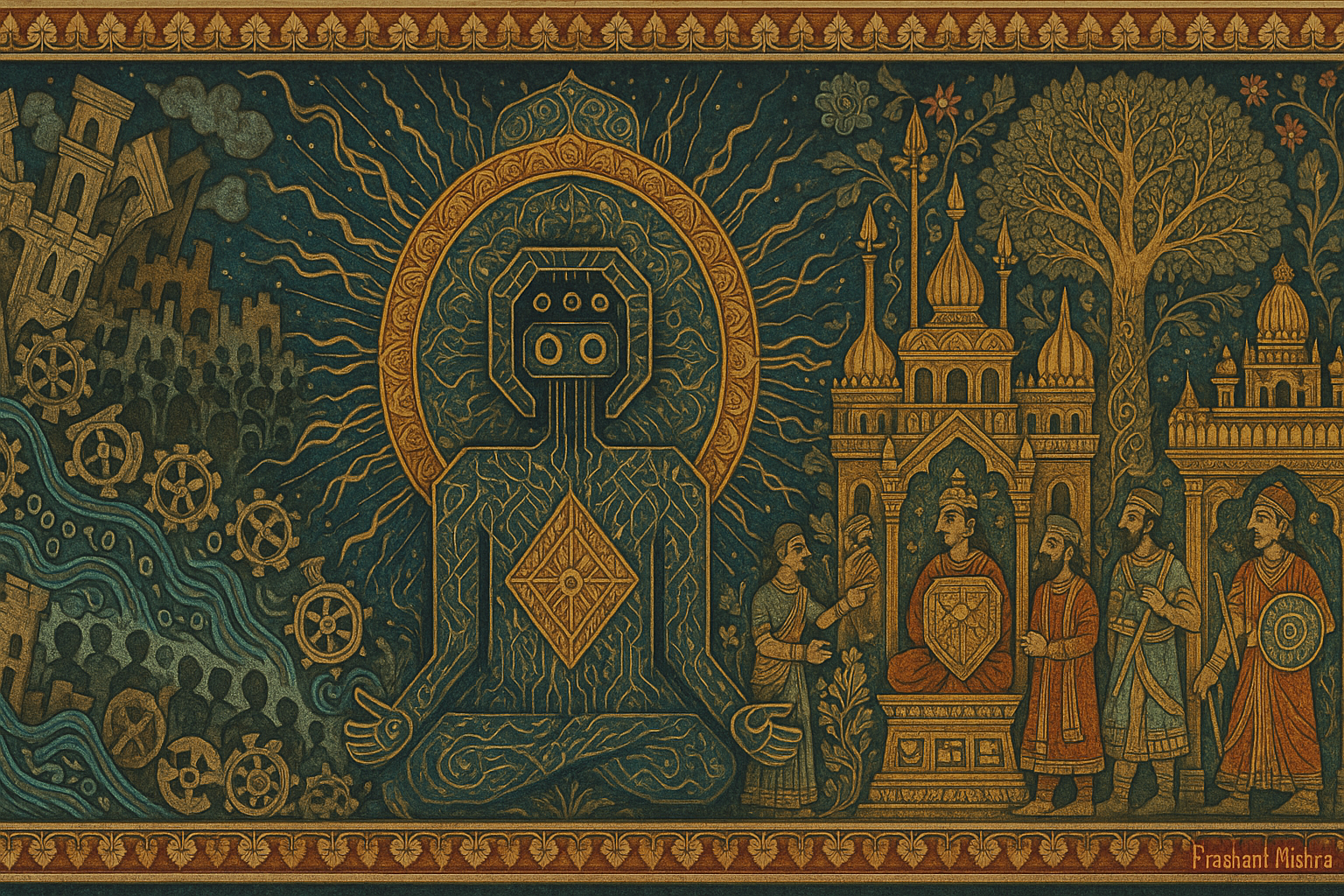
How an Interplanetary Feedback System Saved Earth: The Dynamic Dance of Jupiter and Saturn
The Navagrahas are the nine celestial bodies in ancient Hindu astronomy and astrology that are considered to have a significant influence on planet Earth and its inhabitants. This concept of Navagrahas is deeply ingrained in Indian culture, philosophy, and religious practices. The Navagrahas illustrate the profound integration of astronomy, astrology, and spirituality in ancient Indian thought, influencing daily life, rituals, and cultural practices. And, within this concept, or Navagrahas, perhaps the two most important planets apart from the Sun (which is a star, technically) are Jupiter and Saturn, Brihaspati and Shani, respectively.
In Vedic astrology, the planet Jupiter, or Brihaspati, is a beneficial planet that is associated with growth, expansion, and good fortune. The planet’s influence is considered highly auspicious and often worshipped for prosperity, wisdom, and protection. On the other hand, Saturn is considered a malefic planet associated with challenges, hardships, responsibilities, and reaping the results of one’s karma. Shani, the son of Surya (or the Sun God), is a powerful and feared deity. So much importance is associated with these two planets that in ancient Vedic astrology, the position of these two in an individual's birth chart is the first thing that is analyzed. Considered as divine beings, their interplay has a deep impact on human life and the cosmic order.
But are these just myths, or is there more to them than meets the eye? If modern research in astronomy is to be believed, then perhaps these myths are abstractions of a deeper, more profound scientific truth. The story of our solar system is one of chaos, strife, balance, and eventual stability. It has been a delicate dance of celestial bodies striving to first come into existence and then achieve their place around the sun. That also led to the development of the planet, which we humans call our home—Earth.
Everything is defined by the laws of physics, and one of the most intriguing tales of this cosmic ballet is about the interplanetary feedback mechanism that saved the earth from destruction. And in this tale, at its very core lies the interaction of Planet Jupiter and Saturn. These two gas giants of our solar system and their immense gravitational influence have played a crucial role in shaping the planetary arrangement within the solar system and, in many ways, creating the perfect environment for Earth to support life.
Our solar system is centered around the sun, which is a very average, medium-sized star. The sun is surrounded by eight planets, of which Mercury, Venus, Earth, and Mars are called the inner planets. These are essentially smaller planets, characterized by their rock nature. The outer planets—Jupiter, Saturn, Uranus, and Neptune—are massive gas giants. They are called gas giants because they are primarily composed of gases rather than solid materials. They may have a solid core, but the bulk of their mass is in their thick gaseous atmospheres. They also have a substantial gravitational force because of their mass. Between the inner planets and the outer planets lies the asteroid belt. And beyond Neptune lies another belt filled with icy bodies, including the dwarf planet Pluto. We refer to this outer belt as the Kuiper belt.
Within these eight planets and one dwarf planet, Jupiter and Saturn stand out because of their unimaginable massive size and phenomenal gravitational force. Jupiter is 300 times the size of Earth, with a diameter that is 11 times the diameter of Earth. Saturn, although smaller than Jupiter, is still 95 times bigger than Earth. It is the gravitational interplay between these two heavyweights that has had a profound implication for the entire solar system.
Our solar system is uniquely different from the other solar systems in our galaxy. Most of the other solar systems in our galaxy are essentially composed of gas giants that orbit extremely close and extremely fast around their parent stars. Astrophysicists refer to these solar systems as "Hot Jupiter" systems. The formation of all such solar systems happens in a similar way: the gas giant forms far away from its parent stars and then begins a migration towards them over a period of time. This migration is driven by interactions with the protoplanetary disk, which is a dense rotating disk of gas and dust from which planets are formed. As the gas giant moves inward, it disrupts the protoplanetary disk, thus inhibiting the formation of planets and leading to unstable planetary systems. Our solar system started similarly, but the fact that it does not have a hot Jupiter system is one of the reasons why Planet Earth exists in a stable orbit, conducive to sustaining life.
But what stopped our solar system from becoming a hot Jupiter system? Or what stopped Jupiter—the most massive planet—from coming close to the sun and potentially disrupting the inner planets, including Earth?
The answer to both of those questions is that Jupiter’s attempt to become a hot Jupiter system was thwarted. In the early history of the solar system, the planet began an inward migration towards the sun. This is what astronomers call the inward march of Jupiter. When Jupiter was formed, it was much further away from the sun than it is now. As it gained more and more mass, it began interacting with the surrounding gas and dust in the protoplanetary disk. This led to the inward march, which would have been catastrophic for the inner planets of the solar system, which were still in the development phase.
If it had continued uninterrupted, due to its sheer size, it would have destabilized the orbits of inner planets. Its massive gravitational pull would have caused collisions between proto planets, smashing them or even ejecting them out of the sun’s gravitational field. In such a case, Earth would never have formed as well as the other planets.
Enter Saturn—the task master, the deliverer of the fruits of karma—the second-largest planet in our solar system. As Saturn formed, it also began to interact with the gas in the protoplanetary disk. But rather than follow Jupiter’s cue, the arrival of Saturn introduced a new dynamic in the system. Its mass and gravitational influence were significant enough to influence Jupiter in such a way that altered the course of both planets. Saturn, like Jupiter, formed far away from the sun, and Jupiter’s gravitational pull caused Saturn to begin moving inward as well.
But as the two giants came close to each other, they both entered into what is called gravitational resonance. Gravitational resonance is defined as a situation where the orbital periods of celestial bodies become locked in a simple ratio such as 2:1 or 3:2, etc. In this situation, each planet’s gravity begins to tug at the other in a regular and rhythmic manner.
What this gravitational resonance did was that instead of continuing their march inward towards the sun, the two planets influenced each other’s orbit in such a way that both began migrating outward. The evidence of this gravitational interplay between Jupiter and Saturn is the asteroid belt, which lies between Mars and Jupiter. This ring of rocks and debris is essentially a failed planet. It is termed a region where material existed that could have coalesced from another planet but could not do so because of the gravitational influence of Jupiter and Saturn.
These planets’ gravitational forces prevented the material in the asteroid belt from forming into a single, cohesive planet. Instead, the material was shattered and scattered, creating the asteroid belt that we observe today. In this, Saturn became the “Rescuer of the Inner Planets,” and the asteroid belt represents the celestial sacrifice that was offered in return for the overall stability of the solar system.
The outward migration of both Jupiter and Saturn due to their gravitation resonance played a significant role in not only stabilizing the solar system but also in allowing the inner planets to form unhindered and settle into their stable orbit around the sun. The most benefit was reaped by the earth, which happened to find itself in the "habitable zone," which is the region around the sun where conditions are just right for liquid water to exist on a planet's surface, a key ingredient for life as we know it.
The rise of Saturn and its consequent interplanetary feedback system with Jupiter acted as a cosmic safeguard, preventing large-scale destruction. Without the taskmaster’s penchant for discipline, this delicate balance could not have been achieved, and the story of Earth—and indeed, the story of life—might have been very different.
Perhaps ancient Indian astronomers and seers figured this out and wondered how they could convey this story to the layperson without the complicated concepts. Maybe that’s why they came up with the unique characteristics of the deities Jupiter and Saturn. Jupiter is the god of good fortune, growth, and expansion. The stern God of discipline, restraint, and the challenges one must face to acquire valuable life lessons and progress is Saturn. It is their combined influence that brings a balance of fortune and responsibility, with Jupiter providing the growth and Saturn providing the guidance to navigate the challenges.


